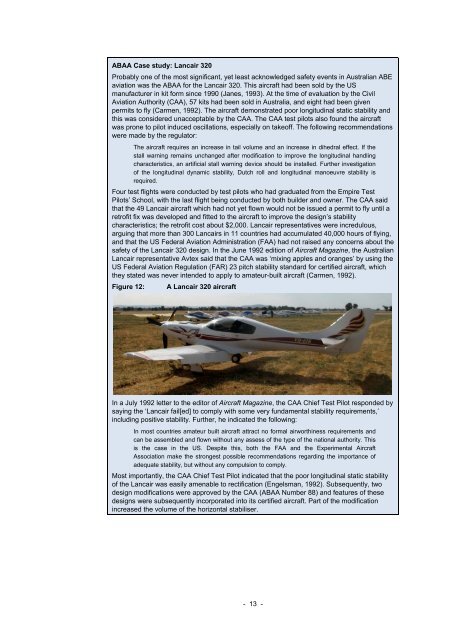Amateur-built and experimental aircraft - Australian Transport Safety ...
Amateur-built and experimental aircraft - Australian Transport Safety ...
Amateur-built and experimental aircraft - Australian Transport Safety ...
Create successful ePaper yourself
Turn your PDF publications into a flip-book with our unique Google optimized e-Paper software.
ABAA Case study: Lancair 320<br />
Probably one of the most significant, yet least acknowledged safety events in <strong>Australian</strong> ABE<br />
aviation was the ABAA for the Lancair 320. This <strong>aircraft</strong> had been sold by the US<br />
manufacturer in kit form since 1990 (Janes, 1993). At the time of evaluation by the Civil<br />
Aviation Authority (CAA), 57 kits had been sold in Australia, <strong>and</strong> eight had been given<br />
permits to fly (Carmen, 1992). The <strong>aircraft</strong> demonstrated poor longitudinal static stability <strong>and</strong><br />
this was considered unacceptable by the CAA. The CAA test pilots also found the <strong>aircraft</strong><br />
was prone to pilot induced oscillations, especially on takeoff. The following recommendations<br />
were made by the regulator:<br />
The <strong>aircraft</strong> requires an increase in tail volume <strong>and</strong> an increase in dihedral effect. If the<br />
stall warning remains unchanged after modification to improve the longitudinal h<strong>and</strong>ling<br />
characteristics, an artificial stall warning device should be installed. Further investigation<br />
of the longitudinal dynamic stability, Dutch roll <strong>and</strong> longitudinal manoeuvre stability is<br />
required.<br />
Four test flights were conducted by test pilots who had graduated from the Empire Test<br />
Pilots’ School, with the last flight being conducted by both builder <strong>and</strong> owner. The CAA said<br />
that the 49 Lancair <strong>aircraft</strong> which had not yet flown would not be issued a permit to fly until a<br />
retrofit fix was developed <strong>and</strong> fitted to the <strong>aircraft</strong> to improve the design’s stability<br />
characteristics; the retrofit cost about $2,000. Lancair representatives were incredulous,<br />
arguing that more than 300 Lancairs in 11 countries had accumulated 40,000 hours of flying,<br />
<strong>and</strong> that the US Federal Aviation Administration (FAA) had not raised any concerns about the<br />
safety of the Lancair 320 design. In the June 1992 edition of Aircraft Magazine, the <strong>Australian</strong><br />
Lancair representative Avtex said that the CAA was ‘mixing apples <strong>and</strong> oranges’ by using the<br />
US Federal Aviation Regulation (FAR) 23 pitch stability st<strong>and</strong>ard for certified <strong>aircraft</strong>, which<br />
they stated was never intended to apply to amateur-<strong>built</strong> <strong>aircraft</strong> (Carmen, 1992).<br />
Figure 12: A Lancair 320 <strong>aircraft</strong><br />
In a July 1992 letter to the editor of Aircraft Magazine, the CAA Chief Test Pilot responded by<br />
saying the ‘Lancair fail[ed] to comply with some very fundamental stability requirements,’<br />
including positive stability. Further, he indicated the following:<br />
In most countries amateur <strong>built</strong> <strong>aircraft</strong> attract no formal airworthiness requirements <strong>and</strong><br />
can be assembled <strong>and</strong> flown without any assess of the type of the national authority. This<br />
is the case in the US. Despite this, both the FAA <strong>and</strong> the Experimental Aircraft<br />
Association make the strongest possible recommendations regarding the importance of<br />
adequate stability, but without any compulsion to comply.<br />
Most importantly, the CAA Chief Test Pilot indicated that the poor longitudinal static stability<br />
of the Lancair was easily amenable to rectification (Engelsman, 1992). Subsequently, two<br />
design modifications were approved by the CAA (ABAA Number 88) <strong>and</strong> features of these<br />
designs were subsequently incorporated into its certified <strong>aircraft</strong>. Part of the modification<br />
increased the volume of the horizontal stabiliser.<br />
- 13 -

















